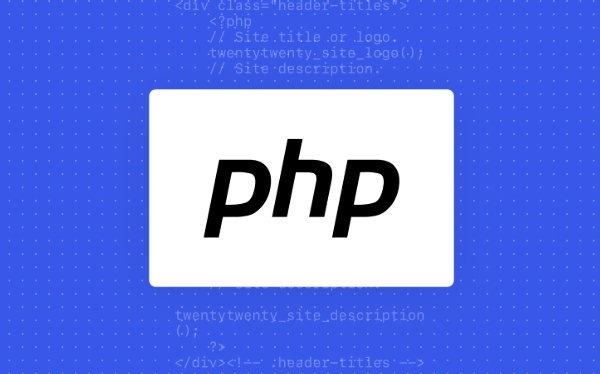There are three ways to implement deep copy of arrays in PHP: First, use unserialize and serialize to disconnect references by serializing and deserializing, which is suitable for ordinary and nested arrays; second, object arrays combine clone and recursive functions to flexibly process mixed types but ensure that the class supports correct cloning; third, json_encode and json_decode are suitable for pure scalar data, with simple writing but no resources or special objects.

When you process an array in PHP, you sometimes need to copy an array without affecting the original data. If you just simply assign values, you might get a shallow copy, especially when the array contains objects or multi-dimensional structures. At this time , deep copy is needed.

PHP does not have a special "deep copy" function, but similar effects can be achieved in several ways.

Use unserialize and serialize
This is the most commonly used and direct way:
$original = [ ['name' => 'Alice'], ['name' => 'Bob'] ]; $copy = unserialize(serialize($original));
- This method completely disconnects the relationship between
$copyand$original. - The principle is to serialize the array into a string first, and then deserialize it back, which is equivalent to reconstructing a new array.
- Suitable for most cases of normal and nested arrays.
What should be noted is:
This method fails if the array contains resource types (such as file handles); in addition, for objects, this method creates new instances, but may have side effects if the __sleep() or __wakeup() methods are defined in the class.

Object arrays can be recursive with cloning
If you have a lot of objects in your array and you want to really copy them deeply, you can combine clone and recursive functions:
function deepCopy($array) {
$result = [];
foreach ($array as $key => $value) {
if (is_array($value)) {
$result[$key] = deepCopy($value);
} elseif (is_object($value)) {
$result[$key] = clone $value;
} else {
$result[$key] = $value;
}
}
return $result;
}This method is more flexible and can also handle arrays of mixed types, but be aware of:
- If there are nested references or resources inside the object,
clonemay not be able to be completely copied; - It is necessary to ensure that the object class supports correct cloning behavior, otherwise it may still be a shallow copy.
Simple arrays can be used directly with json_decode and json_encode
If you are sure that the contents of the array are all basic types (strings, numbers, arrays, etc.), you can also try the JSON method:
$original = [1, 2, [3, 4]]; $copy = json_decode(json_encode($original), true);
The advantage is that it is simple in writing and can indeed disconnect quotations.
The disadvantages are:
- Resources or special objects are not supported;
- Formats such as time and date may be converted into strings;
- Integer keys will be automatically re-indexed (if it is an associative array, it is recommended to set to
trueas the second parameter).
To summarize the applicable scenarios:
- Ordinary array (including multi-dimensional) : the preferred
unserialize(serialize()) - Arrays with objects : consider custom recursive
clone - Pure scalar data : it is easier to use
json_encode/decode
Basically, these methods are all. Although PHP does not have a built-in deep copy function, these techniques can already meet most of the needs.
The above is the detailed content of how to deep copy a php array. For more information, please follow other related articles on the PHP Chinese website!

Hot AI Tools

Undress AI Tool
Undress images for free

Undresser.AI Undress
AI-powered app for creating realistic nude photos

AI Clothes Remover
Online AI tool for removing clothes from photos.

Clothoff.io
AI clothes remover

Video Face Swap
Swap faces in any video effortlessly with our completely free AI face swap tool!

Hot Article

Hot Tools

Notepad++7.3.1
Easy-to-use and free code editor

SublimeText3 Chinese version
Chinese version, very easy to use

Zend Studio 13.0.1
Powerful PHP integrated development environment

Dreamweaver CS6
Visual web development tools

SublimeText3 Mac version
God-level code editing software (SublimeText3)

Hot Topics
 How do I implement authentication and authorization in PHP?
Jun 20, 2025 am 01:03 AM
How do I implement authentication and authorization in PHP?
Jun 20, 2025 am 01:03 AM
TosecurelyhandleauthenticationandauthorizationinPHP,followthesesteps:1.Alwayshashpasswordswithpassword_hash()andverifyusingpassword_verify(),usepreparedstatementstopreventSQLinjection,andstoreuserdatain$_SESSIONafterlogin.2.Implementrole-basedaccessc
 How can you handle file uploads securely in PHP?
Jun 19, 2025 am 01:05 AM
How can you handle file uploads securely in PHP?
Jun 19, 2025 am 01:05 AM
To safely handle file uploads in PHP, the core is to verify file types, rename files, and restrict permissions. 1. Use finfo_file() to check the real MIME type, and only specific types such as image/jpeg are allowed; 2. Use uniqid() to generate random file names and store them in non-Web root directory; 3. Limit file size through php.ini and HTML forms, and set directory permissions to 0755; 4. Use ClamAV to scan malware to enhance security. These steps effectively prevent security vulnerabilities and ensure that the file upload process is safe and reliable.
 What are the differences between == (loose comparison) and === (strict comparison) in PHP?
Jun 19, 2025 am 01:07 AM
What are the differences between == (loose comparison) and === (strict comparison) in PHP?
Jun 19, 2025 am 01:07 AM
In PHP, the main difference between == and == is the strictness of type checking. ==Type conversion will be performed before comparison, for example, 5=="5" returns true, and ===Request that the value and type are the same before true will be returned, for example, 5==="5" returns false. In usage scenarios, === is more secure and should be used first, and == is only used when type conversion is required.
 How do I perform arithmetic operations in PHP ( , -, *, /, %)?
Jun 19, 2025 pm 05:13 PM
How do I perform arithmetic operations in PHP ( , -, *, /, %)?
Jun 19, 2025 pm 05:13 PM
The methods of using basic mathematical operations in PHP are as follows: 1. Addition signs support integers and floating-point numbers, and can also be used for variables. String numbers will be automatically converted but not recommended to dependencies; 2. Subtraction signs use - signs, variables are the same, and type conversion is also applicable; 3. Multiplication signs use * signs, which are suitable for numbers and similar strings; 4. Division uses / signs, which need to avoid dividing by zero, and note that the result may be floating-point numbers; 5. Taking the modulus signs can be used to judge odd and even numbers, and when processing negative numbers, the remainder signs are consistent with the dividend. The key to using these operators correctly is to ensure that the data types are clear and the boundary situation is handled well.
 How can you interact with NoSQL databases (e.g., MongoDB, Redis) from PHP?
Jun 19, 2025 am 01:07 AM
How can you interact with NoSQL databases (e.g., MongoDB, Redis) from PHP?
Jun 19, 2025 am 01:07 AM
Yes, PHP can interact with NoSQL databases like MongoDB and Redis through specific extensions or libraries. First, use the MongoDBPHP driver (installed through PECL or Composer) to create client instances and operate databases and collections, supporting insertion, query, aggregation and other operations; second, use the Predis library or phpredis extension to connect to Redis, perform key-value settings and acquisitions, and recommend phpredis for high-performance scenarios, while Predis is convenient for rapid deployment; both are suitable for production environments and are well-documented.
 How do I stay up-to-date with the latest PHP developments and best practices?
Jun 23, 2025 am 12:56 AM
How do I stay up-to-date with the latest PHP developments and best practices?
Jun 23, 2025 am 12:56 AM
TostaycurrentwithPHPdevelopmentsandbestpractices,followkeynewssourceslikePHP.netandPHPWeekly,engagewithcommunitiesonforumsandconferences,keeptoolingupdatedandgraduallyadoptnewfeatures,andreadorcontributetoopensourceprojects.First,followreliablesource
 What is PHP, and why is it used for web development?
Jun 23, 2025 am 12:55 AM
What is PHP, and why is it used for web development?
Jun 23, 2025 am 12:55 AM
PHPbecamepopularforwebdevelopmentduetoitseaseoflearning,seamlessintegrationwithHTML,widespreadhostingsupport,andalargeecosystemincludingframeworkslikeLaravelandCMSplatformslikeWordPress.Itexcelsinhandlingformsubmissions,managingusersessions,interacti
 How to set PHP time zone?
Jun 25, 2025 am 01:00 AM
How to set PHP time zone?
Jun 25, 2025 am 01:00 AM
TosettherighttimezoneinPHP,usedate_default_timezone_set()functionatthestartofyourscriptwithavalididentifiersuchas'America/New_York'.1.Usedate_default_timezone_set()beforeanydate/timefunctions.2.Alternatively,configurethephp.inifilebysettingdate.timez






